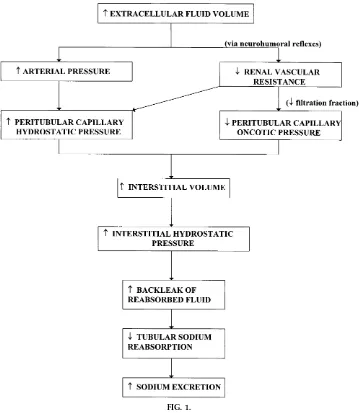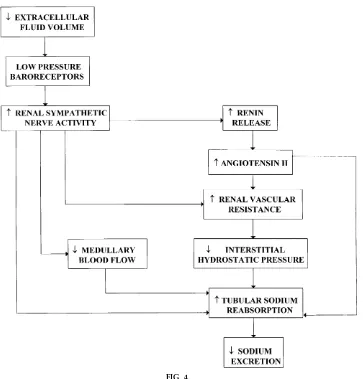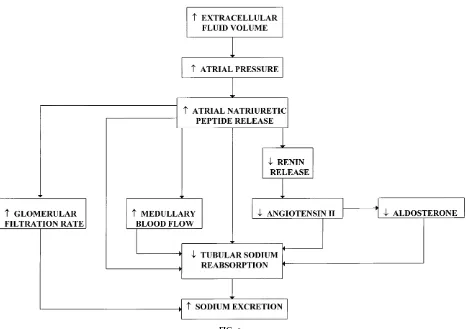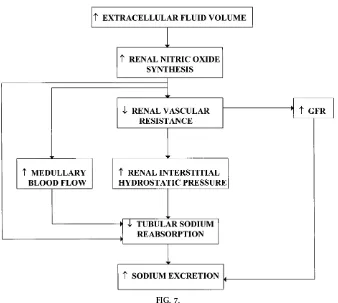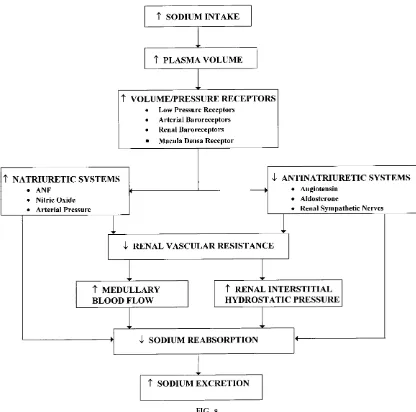REGULATION OF EX TRACELLULAR FLUID VOLUME
BY INTEGRATED CONTROL OF SODIUM EX CRETION
Joey P. Granger
Depa rtm ent of Physiology a nd Biophysics, University of Mississippi Medica l Center, Ja ck son, Mississippi 39216-4505
T
he ability of the kidneys to regulate extracellular fluid volume by altering sodium excretion is important for maintaining adequate volume within the vascular system. Sodium excretion is controlled by integrating physical, neural, and hormonal regulatory systems. The major systems involved in retaining sodium include the renin-angiotensin-aldosterone and sympathetic systems, whereas natriuretic factors such as atrial natriuretic peptide and nitric oxide are important in promoting sodium excretion. In response to increased sodium intake, the sodium-retaining systems are inhibited and natriuretic hormones are activated. Pressures and flows within the microcirculation of the kidney, in concert with neural and hormonal systems, interact to regulate sodium excretion. The quantitative importance of each of these systems in regulating sodium balance is variable and is determined by the physiological or pathiophysiological condition.AM. J. PHYSIOL. 275 (ADV. PHYSIOL. EDUC. 20): S157–S168, 1998.
EXTRACELLULAR FLUID VOLUME IS
DETERMINED BY BALANCE BETWEEN SODIUM INTAKE AND RENAL EXCRETION OF SODIUM
The ability of the kidneys to regulate extracellular fluid volume by altering sodium excretion is impor-tant for maintaining adequate volume within the vascular system. This ensures that appropriate tissue perfusion occurs under various physiological condi-tions. Provided that the antidiuretic and thirst systems are functional, changes in the balance between so-dium intake and soso-dium output determined the total qua ntityof sodium in the body and the volume of the extracellular compartment (11, 12). For example, when sodium intake exceeds sodium output by the kidneys, total body sodium (not Na1
concentration) and extracellular fluid volume increases. Conversely, when renal excretion of sodium exceeds sodium intake, total body sodium and extracellular fluid vol-ume decrease. Thus the maintenance of a constant extracellular fluid volume depends on the body’s
ability to regulate the amount of NaCl in the compart-ment. The body achieves this important regulatory function by varying sodium excretion to match the level of sodium intake.
CHANGES IN SODIUM BALANCE ARE SENSED BY VOLUME-DEPENDENT RECEPTORS
receptors are located in the low- and high-pressure portions of the cardiovascular system.
The low-pressure receptors are found in the pulmo-nary vasculature and in the atria. An increase in atrial pressure in response to an increase in plasma volume activates two effector mechanisms that enhance so-dium excretion (10, 11, 12). An increase in atrial pressure decreases renal sympathetic nerve activity via a neural reflex mechanism and increases the release of atrial natriuretic peptide (ANP) from atrial myocytes (3, 4). Conversely, a decrease in plasma volume reduces atrial pressure, which leads to en-hanced renal sympathetic nerve activity and de-creased ANP secretion.
Under certain conditions, an increase in plasma vol-ume leads to increases in arterial pressure. Changes in arterial pressure are sensed by high-pressure recep-tors located in the aortic arch and the carotid sinus (3). Increases in arterial pressure result in baroreceptor-mediated reductions in renal sympathetic nerve activ-ity, whereas a decrease in arterial pressure leads to enhanced renal sympathetic nerve activity and so-dium retention.
Changes in plasma volume can also be sensed by two different types of intrarenal volume-dependent recep-tors (10, 11, 12). Changes in arterial pressure are sensed by pressure receptors located in the afferent arterioles. Decreases in arterial pressure at the level of the afferent arteriole lead to renin secretion and enhanced formation of angiotensin II (ANG II), which is a sodium-retaining hormone. Changes in plasma volume can also lead to alterations in NaCl delivery to macula densa cells, which in turn alters renin secre-tion. Increases in plasma volume lead to an increase in sodium delivery [via a decrease in proximal tubule reabsorption and/or increase in glomerular filtration rate (GFR)] to macula densa cells, which in turn suppresses renin release. Conversely, a decrease in plasma volume leads to a decrease in sodium delivery to macula densa cells and enhanced renin secretion and angiotensin formation.
Thus changes in extracellular fluid volume are de-tected by various sensors in the body, which activate effector mechanisms that adjust sodium excretion appropriately to return extracellular fluid volume to
normal levels. The effector mechanisms involved in adjusting sodium excretion involve neural and hor-monal factors. These factors alter the rate of sodium excretion by influencing the main determinants of sodium excretion, GFR, and tubule sodium reabsorp-tion. The quantity of sodium excreted is determined by the difference between the filtered load of sodium and the amount of sodium reabsorbed along the nephron. Thus an increase in sodium excretion can occur via an increase in glomerular filtration or a decrease in sodium reabsorption. Conversely, a de-crease in sodium excretion can occur via a dede-crease in glomerular filtration or an increase in sodium reabsorp-tion. The remaining part of this brief review will focus on how specific neurohormonal effector mechanisms regulate sodium excretion via alterations in glomeru-lar filtration and tubuglomeru-lar sodium reabsorption.
CHANGES IN PERITUBULAR CAPILLARY PHYSICAL FACTORS INFLUENCE SODIUM REABSORPTION BY ALTERING INTERSTITIAL HYDROSTATIC PRESSURE
Expansion of the extracellular fluid volume compart-ment results in an increases in peritubular capillary hydrostatic pressure (due to renal vasodilation and/or increases in arterial pressure) and a decrease in colloid osmotic pressure (due to a decrease in filtration fraction). These changes result in a reduced rate of sodium and water reabsorption in the proximal tu-bules (7, 11, 12). Conversely, when extracellular fluid volume is contracted, decreases in peritubular capil-lary hydrostatic pressure and increases in colloid osmotic pressure enhance the rate of sodium reabsorp-tion in the proximal tubule.
Changes in peritubular capillary physical forces are thought to influence sodium reabsorption by changes in renal interstitial volume or hydrostatic pressure (see Fig. 1). Numerous physiological perturbations that increase sodium excretion such as increases in renal perfusion pressure or extracellular fluid volume expan-sion are associated with significant elevations in renal interstitial hydrostatic pressure (RIHP) (6, 7). Further-more, renal vasodilators that cause natriuresis also increase RIHP (7). In contrast, renal vasodilators, such as secretin, that do not increase sodium excretion also do not increase RIHP (7). Finally, when RIHP is
FIG. 1.
prevented from increasing during renal vasodilatation or acute saline volume expansion, natriuresis is mark-edly attenuated or even abolished (7). Thus RIHP appears to link changes in peritubular capillary hemo-dynamics to sodium reabsorption.
Although the exact mechanism whereby RIHP influ-ences the reabsorption of sodium and water is un-clear, it is thought that RIHP decreases sodium absorp-tion in the proximal tubule by inhibiting passive sodium and water transport (7). One hypothesis is that increased renal interstitial volume and/or pres-sure raises the permeability of the tight junctional complexes of the proximal tubule. This effect would, in turn, increase the back leak of sodium from the interstitium into the tubule lumen. The net effect would be a reduction of sodium and water reabsorp-tion across the proximal tubule. Conversely, a de-crease in RIHP would reduce back leak of sodium from the interstitium and enhance proximal tubule sodium reabsorption.
CHANGES IN MEDULLARY BLOOD FLOW INFLUENCE SODIUM REABSORPTION IN LOOP OF HENLE
In addition to the influence of the cortical peritubular microcirculation on sodium reabsorption, it has been shown that alterations in medullary hemodynamics affect passive sodium transport in the loop of Henle (10, 11, 15). An increase in medullary blood flow leads to a washout of medullary interstitial hypertonicity (see Fig. 2). Consequently, water abstraction out of the thin descending limb of Henle’s loop, which is relatively impermeable to sodium, is reduced. Thus an increased volume of fluid with the same quantity of sodium but decreased sodium concentration is deliv-ered to the water-impermeable thin ascending limb of Henle’s loop. The reduced sodium concentration decreases sodium reabsorption in that nephron seg-ment, and more sodium is delivered to the distal tubules and eventually excreted.
In contrast, reductions in medullary blood flow would decrease sodium excretion by increasing medullary interstitial tonicity, water abstraction out of the thin descending loop of Henle, and sodium concentration in the thin ascending limb of Henle’s loop. The
increased sodium concentration would increase pas-sive sodium reabsorption in this nephron segment.
A variety of neurohumoral factors, such as angioten-sin, norepinephrine, and ANP, and local autocoid factors, such as prostaglandins and nitric oxide (NO), influence medullary blood flow (15). Thus the effects
FIG. 2.
of these factors on sodium excretion could, in part, be due to alterations in medullary hemodynamics.
CHANGES IN RENAL ARTERY PRESSURE INFLUENCE SODIUM REABSORPTION VIA ALTERATIONS IN INTRARENAL
HEMODYNAMICS
Increases in renal perfusion pressure enhance sodium excretion, a phenomenon commonly referred to as renal pressure natriuresis (2, 6, 8). Changes in sodium excretion in response to changes in renal perfusion pressure are thought to be due to alterations in tubular reabsorption of sodium, because GFR and the filtered load of sodium are usually well autoregulated. Al-though renal pressure natriuresis plays a critical role in the long-term regulation of extracellular fluid vol-ume and arterial pressure, the mechanisms whereby changes in renal perfusion pressure influence sodium excretion and, specifically, sodium reabsorption, have not been fully elucidated (2, 8, 10). Research investiga-tions during recent years, however, have provided new insights into possible mechanisms of pressure natriuresis and have suggested that physical factors, especially renal interstitial pressure, may be primary mediators of pressure natriuresis (7).
Some investigators have argued against a role for RIHP in mediating pressure natriuresis, because renal blood flow and/or peritubular capillary hydrostatic pressure is usually autoregulated in response to changes in renal perfusion pressure (7). Direct measurement of RIHP, however, indicates that increased RIHP may occur despite efficient autoregulation of whole kidney renal blood flow and peritubular capillary hydrostatic pressure (7). Moreover, preventing RIHP from increas-ing in response to increased renal perfusion pressure markedly attenuates pressure natriuresis (7). Direct increases in RIHP, comparable to those measured in response to increased renal perfusion pressure, also significantly decrease proximal tubular sodium reab-sorption and increase sodium excretion.
Because pressure natriuresis can occur in the absence of discernible changes in renal blood flow and peritu-bular capillary hydrostatic and oncotic pressures, the mechanisms responsible for sustained increased RIHP have been unclear. Recent studies, however, have provided evidence that renal medullary
hemodynam-ics are closely linked to changes in RIHP (7). Increases in renal perfusion pressure raise vasa recta flow and hydrostatic pressure, possibly reducing fluid uptake across the vasa recta capillary wall and increasing medullary interstitial volume and medullary interstitial hydrostatic pressure (see Fig. 3). The increase in medullary interstitial hydrostatic pressure is then thought to be transmitted throughout the kidney, including the cortex (15).
Why papillary plasma flow increases when renal perfusion pressure is elevated and cortical blood flow is effectively autoregulated is unknown. It is possible that endothelial (NO) or interstitial factors (ANG II, prostaglandins, kinins) are released into the medulla with increased renal perfusion pressure (7, 15). Once released, these intrarenal factors could then alter medullary hemodynamics and override intrinsic auto-regulatory mechanisms in the inner medulla.
FIG. 3.
ACTIVATION OF RENAL SYMPATHETIC NERVOUS SYSTEM REDUCES SODIUM EXCRETION BY DECREASING GFR AND ENHANCING SODIUM REABSORPTION
Because the kidneys receive extensive sympathetic innervation, alterations in renal nerve traffic are be-lieved to play an important role in the regulation of sodium excretion and extracellular fluid volume (3, 10, 11, 12). The renal sympathetic nervous system is activated via peripheral and central reflex mecha-nisms. In response to acute reductions in extracellular fluid volume, for example, intrathoracic volume/ pressure receptors are thought to initiate a neural reflex that, in turn, enhances renal sympathetic nerve
activity and reduces sodium excretion. Conversely, increases in central volume lead to a reduction in renal nerve traffic and natriuresis.
Direct renal nerve stimulation reduces sodium excre-tion, whereas acute renal denervation enhances pres-sure natriuresis (3). Increases in renal sympathetic nerve activity could reduce sodium excretion by increasing tubular reabsorption or decreasing the filtered load of sodium (see Fig. 4). Renal nerves are known to act directly on the tubule to increase sodium reabsorption via ana-adrenergic receptor. In
addition, increases in renal sympathetic nerve activity influence tubule reabsorption by activating the renin
FIG. 4.
angiotensin system. Marked increases in renal sympa-thetic nerve activity may also raise renal vascular resistance and decrease GFR, medullary blood flow, and renal interstitial pressure, changes that could all contribute to the sodium-retaining effects of renal nerve activation.
Most of the experimental evidence suggests that this system plays a role in regulating sodium excretion under conditions associated with marked sodium retention, such as in congestive heart failure, cirrho-sis, and a low-sodium diet (3, 10, 11, 12). There is also evidence to suggest that excessive activation of the sympathetic nervous system may play a role in the pathogenesis of certain forms of hypertension such as in obesity-related hypertension.
ALDOSTERONE ENHANCES SODIUM REABSORPTION IN CORTICAL COLLECTING DUCT
Aldosterone is a potent sodium-retaining hormone that is synthesized in the zona glomerulosa of the adrenal cortex. Although several factors (plasma K1 and Na1
, ACTH, and ANP) influence its secretion, ANG II is the most important in controlling aldoste-rone secretion in response to changes in extracellular fluid volume. Increases in plasma ANG II enhance aldosterone secretion, whereas reduced plasma ANG II decreases aldosterone secretion. There is also a strong inverse relationship between sodium intake and plasma aldosterone concentration. A low-sodium diet is associated with high levels of plasma aldoste-rone. Conversely, plasma aldosterone concentration approaches zero in individuals with a high sodium intake.
Aldosterone decreases sodium excretion by enhanc-ing renal sodium reabsorption. Aldosterone increases sodium reabsorption in principal cells of the collect-ing duct by increascollect-ing the sodium permeability of the luminal membrane and by stimulating Na1
-K1 -ATPase activity. Aldosterone permeates the cell membrane of the principal cells and binds to a cytosolic receptor (11). The aldosterone/receptor complex is translo-cated into the nucleus, where it activates the transcrip-tion of specific mRNA. The newly formed proteins called aldosterone-induced proteins are involved in mediating the increase in sodium permeability of the luminal membrane and Na1
-K1
-ATPase activity.
Spi-ronolactone, an aldosterone receptor antagonist, is used clinically to promote sodium loss in sodium retaining states such as congestive heart failure, cirrho-sis, and hyperaldosteronism.
ANG II ENHANCES SODIUM REABSORPTION VIA A DIRECT EFFECT ON TUBULE TRANSPORT AND BY INDIRECT HEMODYNAMIC
MECHANISMS
The renin-angiotensin system is the most thoroughly studied, and perhaps most important, system primar-ily responsible for the regulation of sodium excretion (9). During extracellular fluid volume contraction, renin is released from the kidneys. Renin acts on a substrate to release ANG I, which is rapidly converted to ANG II by a converting enzyme located in the pulmonary circulation and in the kidney itself.
For many years ANG II was thought to affect sodium excretion solely through the release of aldosterone, which acts on the cortical tubules to enhance sodium reabsorption (9). However, more recent studies have provided evidence that ANG II can stimulate sodium reabsorption through a direct action on ANG II receptors located on the renal tubules and by reduc-ing medullary blood flow and renal interstitial hydro-static pressure (see Fig. 5).
IN RESPONSE TO ATRIAL DISTENTION, THE HEART RELEASES A HORMONE THAT ENHANCES SODIUM EXCRETION
ANP is a 28-amino acid peptide hormone that is synthesized by atrial myocytes and secreted in re-sponse to increased atrial distention. Conversely, ANP secretion is reduced in response to reductions in atrial pressure (1, 3, 5).
Figure 6 shows pathways whereby ANP is released and then acts through direct and indirect mechanisms to enhance sodium excretion. ANP increases sodium excretion by increasing GFR and reducing sodium reabsorption; however, an increase in GFR is not essential for the natriuresis. Inhibition of sodium reabsorption occurs through direct and indirect ef-fects on the renal tubules. ANP directly inhibits FIG. 5.
sodium reabsorption in the collecting duct via a cGMP-mediated reduction in sodium permeability. ANP decreases sodium reabsorption indirectly by increasing medullary blood flow and inhibiting the formation of ANG II and aldosterone.
The quantitative importance of ANP in controlling sodium excretion is uncertain due to the lack of effort via experimental tools to block the synthesis or effector site of ANP. Increases in dietary sodium intake result in relatively small increases in plasma ANP concentration. Thus its importance in regulation so-dium balance in response to increments in soso-dium intake is unclear. ANP is thought to play an important role in controlling sodium excretion under conditions of severe volume overload such as congestive heart failure. Under these conditions ANP is believed to play
a role in protecting the body from severe volume retention and edema formation.
NITRIC OXIDE IS SYNTHESIZED BY RENAL ENDOTHELIAL AND TUBULE CELLS AND PROMOTES SODIUM EXCRETION
NO is synthesized from the amino acid L-arginine in endothelial as well as other renal tubule cells by the action of NO synthase (13, 14). The characterization and cloning of constitutive and inducible NO-synthesiz-ing enzymes and the development of specific inhibi-tors of the L-arginine-NO pathway have provided powerful tools to examine the role of NO in the regulation of renal hemodynamics and sodium excre-tion (13, 14, 16). NO is believed to enhance sodium excretion by increasing glomerular filtration and by FIG. 6.
inhibiting tubular sodium reabsorption (see Fig. 7). NO directly inhibits sodium transport in the collecting duct (13, 16). In addition, NO decreases tubular reabsorption by enhancing medullary blood flow ad increasing renal interstitial hydrostatic pressure (13, 16). NO may also decrease tubular odium reabsorp-tion by antagonizing the renal tubular acreabsorp-tions of ANG II studies (13, 16).
Recent studies indicate that NO may be important in the regulation of sodium excretion (13, 16). All three isoforms of NO synthase are found in the kidney, and there is evidence to suggest that NO synthesis in-creases in response to inin-creases in sodium intake and other stimuli that increase sodium excretion such as increases in renal perfusion pressure.
The mechanism whereby increases in extracellular fluid volume increase NO production, however, has yet been fully elucidated. Blockade of endogenous NO formation reduces sodium excretion. In addition,
chronic blockade of NO synthesis results in a salt-sensitive form of hypertension. Thus it appears that NO is involved in the normal regulation of extracellu-lar fluid volume and arterial pressure.
SODIUM EXCRETION RESPONSE TO
ELEVATIONS IN SODIUM INTAKE INVOLVES INTEGRATION OF NEURAL, HORMONAL, AND PHYSICAL FACTORS
The integration of control systems regulating sodium excretion under normal conditions can be summa-rized by examining the homeostatic response to progressive increases in dietary sodium intake (see Fig. 8). The primary purpose of the homeostatic response is to enhance sodium excretion and maintain a balance between sodium intake and renal sodium output. As sodium intake is increased, sodium output initially lags behind intake. This time delay in sodium excretion results in a positive cumulative sodium balance and an increase, albeit small, in extracellular FIG. 7.
fluid volume. It is this small increase in extracellular fluid volume that triggers various volume and/or low-pressure receptors in the body to increase sodium excretion. Activating these receptors suppresses so-dium-retaining systems and activates sodium-losing systems. Under normal conditions, progressive in-creases in sodium intake reduce renin release, ANG II formation, and aldosterone secretion. The elevation in extracellular fluid volume may also lead to a reduction in renal sympathetic nerve activity. In contrast to the sodium-retaining systems, natriuretic systems, such as the ANP and NO systems, are likely to be activated during progressive increases in dietary sodium intake.
The combined activation of natriuretic systems and suppression of sodium-retaining systems leads to an increase in sodium excretion, partly through reduc-tions in sodium reabsorption and increases in glomeru-lar filtration. These systems act on the kidneys to decrease sodium reabsorption directly by inhibiting sodium transport and indirectly by increasing RIHP and medullary blood flow. Maintaining sodium bal-ance during chronic increases in sodium intake nor-mally occurs without marked increases in renal perfu-sion pressure. Thus the neural and hormonal systems are sufficiently effective under normal conditions to maintain sodium balance without marked increases in FIG. 8.
renal perfusion pressure. Thus the neural and hor-monal systems are sufficiently effective under normal conditions to maintain sodium balance without exces-sive volume retention and hypertension. However, when a derangement in an important regulatory system occurs, activation of other natriuretic mecha-nisms, such as a rise in arterial pressure, becomes an important compensatory mechanism for maintaining sodium balance.
The importance of pressure/natriuresis can be illus-trated in the homeostatic response to increased so-dium intake when ANG II production is unable to be suppressed. Because ANG II is unable to respond to further increments in sodium intake, more sodium is retained, causing increases in extracellular fluid vol-ume and arterial pressure that help to restore sodium balance. Another possible factor for maintaining so-dium balance may be the release of natriuretic factors, such as atrial natriuretic factor (ANF). Circulatory levels of this natriuretic substance are elevated under these conditions; however, its quantitative impor-tance in achieving sodium balance has not been determined.
Thus sodium excretion is controlled by integrating physical, neural, and hormonal regulatory systems. The major systems involved in retaining sodium in-clude the renin-angiotensin-aldosterone and sympa-thetic systems, whereas natriuretic factors such as ANP and NO are important in promoting sodium excretion. In response to increased sodium intake, the sodium-retaining systems are inhibited and natriuretic hormones are activated. Pressures and flows within the microcirculation of the kidney, in concert with neural and hormonal systems, interact to regulate sodium excretion. The quantitative importance of each of these systems in regulating sodium balance is variable and is determined by the physiological or pathophysiological condition.
This work is supported in part by National Heart, Lung, and Blood Intitute Grants HL-3499 and HL-51971.
Address for reprint requests: J. P. Granger, Dept. of Physiology and Biophysics, Univ. of Mississippi Medical Center, 2500 N. State St., Jackson, MS 39216-4505.
Refer ences
1. Bur nett, J. C., Jr., J. P. Granger, and T. J. Opgenorth.Effects of synthetic atrial natriuretic factor on renal function and renin release.Am . J. Physiol. 247 (Rena l Fluid Electrolyte Physiol. 16): F863–F866, 1984.
2. Cowley, A. W., Jr.Long-term control of arterial blood pressure.
Physiol. Rev. 72: 231–300, 1992.
3. DiBona, G. F.The functions of the renal nerves.Rev. Physiol. Biochem . Pha rm a col. 94: 76–181, 1982.
4. Genest, J., and M. Cantin.Regulation of body fluid volume: the atrial natriuretic factor.News Physiol. Sci. 1: 3–5, 1986. 5. Granger, J. P.Inhibitors of ANF metabolism: potential
therapeu-tic agents in cardiovascular disease.Circula tion82: 313–315, 1990.
6. Granger, J. P. Pressure-natriuresis: role of renal interstitial hydrostatic pressure.Hypertension19: I9–I17, 1992.
7. Granger, J. P.Role of renal interstitial hydrostatic pressure in the regulation of sodium excretion. Federa tion Proc. 45: 840–844, 1986.
8. Guyton, A. C., T. G. Coleman, A. W. Cowley, Jr., K. W. Scheel, R. D. Manning, and R. A. Nor man.Arterial pressure regulation: overriding dominance of the kidneys in long-term regulation and in hypertension.Am . J. Med. 52: 584–594, 1972. 9. Hall, J. E. Control of sodium excretion by angiotensin II: intrarenal mechanisms and blood pressure regulation. Am . J. Physiol. 250 (Regula tory Integra tive Com p. Physiol. 19): R960–R972, 1986.
10. Hall, J. E., and J. P. Granger. Role of sodium and fluid excretion in hypertension. In: Textbook of Hypertension, edited by J. D. Swales. Oxford, UK: Blackwell Scientific, 1994, p. 360–387.
11. Knox , F. G., and J. P. Granger.Control of sodium excretion: an integrative approach. In:Ha ndbook of Rena l Physiology, edited by E. Windhager. New York: Oxford Univ. Press, 1992, p. 927–967.
12. Knox , F. G., and J. P. Granger.Control of sodium excretion: the kidney produces under pressure. News Physiol. Sci. 2: 26–29, 1987.
13. Kone, B. C., and C. Baylis.Biosynthesis and homeostatic roles of nitric oxide in the normal kidney.Am . J. Physiol. 272 (Rena l Physiol. 41): F561–F578, 1997.
14. Moncada, S., R. M. J. Palmer, and E. A. Higgs.Nitric oxide: physiology, pathophysiology and pharmacology. Pha rm a col. Rev. 43: 109–142, 1991.
15. Roman, R. J., and A.-P. Zou.Influence of the renal medullary circulation on the control of sodium excretion.Am . J. Physiol. 265 (Regula tory Integra tive Com p. Physiol. 14): R963–R973, 1993.
